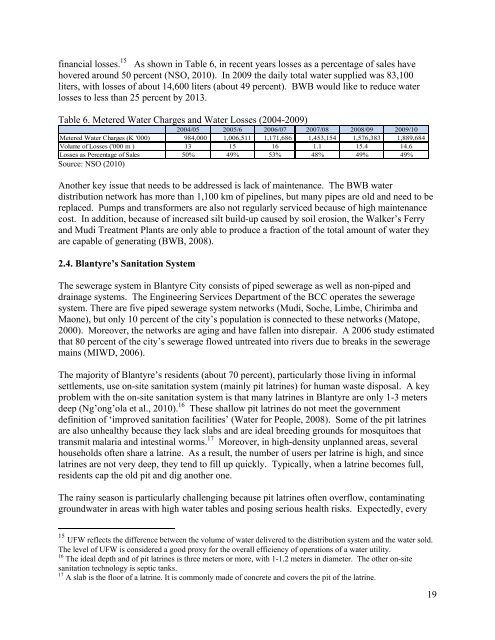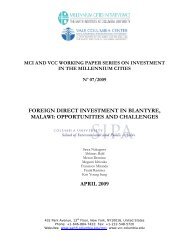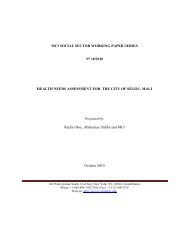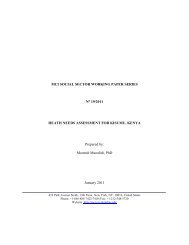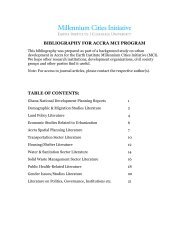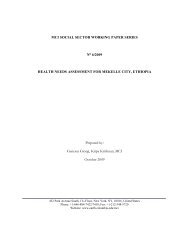Water and Sanitation Needs Assessment for Blantyre City, Malawi
Water and Sanitation Needs Assessment for Blantyre City, Malawi
Water and Sanitation Needs Assessment for Blantyre City, Malawi
Create successful ePaper yourself
Turn your PDF publications into a flip-book with our unique Google optimized e-Paper software.
financial losses. 15 As shown in Table 6, in recent years losses as a percentage of sales have<br />
hovered around 50 percent (NSO, 2010). In 2009 the daily total water supplied was 83,100<br />
liters, with losses of about 14,600 liters (about 49 percent). BWB would like to reduce water<br />
losses to less than 25 percent by 2013.<br />
Table 6. Metered <strong>Water</strong> Charges <strong>and</strong> <strong>Water</strong> Losses (2004-2009)<br />
2004/05 2005/6 2006/07 2007/08 2008/09 2009/10<br />
Metered <strong>Water</strong> Charges (K '000) 984,000 1,006,511 1,171,686 1,453,154 1,576,383 1,889,684<br />
Volume of Losses ('000 m ) 13 15 16 1.1 15.4 14.6<br />
Losses as Percentage of Sales 50% 49% 53% 48% 49% 49%<br />
Source: NSO (2010)<br />
Another key issue that needs to be addressed is lack of maintenance. The BWB water<br />
distribution network has more than 1,100 km of pipelines, but many pipes are old <strong>and</strong> need to be<br />
replaced. Pumps <strong>and</strong> trans<strong>for</strong>mers are also not regularly serviced because of high maintenance<br />
cost. In addition, because of increased silt build-up caused by soil erosion, the Walker’s Ferry<br />
<strong>and</strong> Mudi Treatment Plants are only able to produce a fraction of the total amount of water they<br />
are capable of generating (BWB, 2008).<br />
2.4. <strong>Blantyre</strong>’s <strong>Sanitation</strong> System<br />
The sewerage system in <strong>Blantyre</strong> <strong>City</strong> consists of piped sewerage as well as non-piped <strong>and</strong><br />
drainage systems. The Engineering Services Department of the BCC operates the sewerage<br />
system. There are five piped sewerage system networks (Mudi, Soche, Limbe, Chirimba <strong>and</strong><br />
Maone), but only 10 percent of the city’s population is connected to these networks (Matope,<br />
2000). Moreover, the networks are aging <strong>and</strong> have fallen into disrepair. A 2006 study estimated<br />
that 80 percent of the city’s sewerage flowed untreated into rivers due to breaks in the sewerage<br />
mains (MIWD, 2006).<br />
The majority of <strong>Blantyre</strong>’s residents (about 70 percent), particularly those living in in<strong>for</strong>mal<br />
settlements, use on-site sanitation system (mainly pit latrines) <strong>for</strong> human waste disposal. A key<br />
problem with the on-site sanitation system is that many latrines in <strong>Blantyre</strong> are only 1-3 meters<br />
deep (Ng’ong’ola et al., 2010). 16 These shallow pit latrines do not meet the government<br />
definition of ‘improved sanitation facilities’ (<strong>Water</strong> <strong>for</strong> People, 2008). Some of the pit latrines<br />
are also unhealthy because they lack slabs <strong>and</strong> are ideal breeding grounds <strong>for</strong> mosquitoes that<br />
transmit malaria <strong>and</strong> intestinal worms. 17 Moreover, in high-density unplanned areas, several<br />
households often share a latrine. As a result, the number of users per latrine is high, <strong>and</strong> since<br />
latrines are not very deep, they tend to fill up quickly. Typically, when a latrine becomes full,<br />
residents cap the old pit <strong>and</strong> dig another one.<br />
The rainy season is particularly challenging because pit latrines often overflow, contaminating<br />
groundwater in areas with high water tables <strong>and</strong> posing serious health risks. Expectedly, every<br />
15<br />
UFW reflects the difference between the volume of water delivered to the distribution system <strong>and</strong> the water sold.<br />
The level of UFW is considered a good proxy <strong>for</strong> the overall efficiency of operations of a water utility.<br />
16<br />
The ideal depth <strong>and</strong> of pit latrines is three meters or more, with 1-1.2 meters in diameter. The other on-site<br />
sanitation technology is septic tanks.<br />
17<br />
A slab is the floor of a latrine. It is commonly made of concrete <strong>and</strong> covers the pit of the latrine.<br />
19


